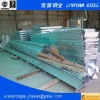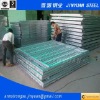provide Hot-dip galvanizing HDG service galvanization galvanized Hot-dip HDG
The hot-dip galvanizing is a way to improve the surface treatment method for steel in the rust preventing capability. Hot dip galvanized steel parts in lye degreasing, rust in the acid (hydrochloric acid or sulfuric acid) of a certain ingredient, exposing a clean metal surface, and then immersed in the molten galvanizing pot, which in the system pieces, covered by a layer of uniform zinc layer on the galvanized layer anti-corrosion of the steel pieces greater capacity, extending its life. As usual to see the highway guardrail, transmission tower after hot galvanized, these devices are generally up to fifty years will not rust.
Company specializing in hot dip galvanizing process, hot-dip zinc contract steel structures, transmission line towers, light poles, microwave towers, shipbuilding, iron pieces, a variety of profiles, seamless pipe, highway guardrail, traffic signs iron pieces, the company covers an area ofarea of 30,000 square meters and a building area of 1,800 square meters, unique scale in the province.The company now has 20 employees, 13 professional engineers, technicians, skilled workers, and strong technical force. Became the hot dip galvanizing process, hot-dip zinc-lead level
Of hot galvanized principle and process description
1 IntroductionHot dip galvanized also known as hot-dip galvanized steel structures immersed in molten zinc liquid metal covering a method. In recent years, with the high-voltage transmission, transportation, communication, career development rapidly increasing protection requirements of the iron and steel parts, also increasing the demand for hot-dip galvanizing.2 hot dip galvanized layer protection performance Usually electrically galvanized layer thickness 5 ~~ 15μm, while the galvanized layer is generally more than 35μm, or even up to 200μm. Hot-dip galvanizing good covering power, dense coating no organics inclusion. Is well known, zinc atmospheric corrosion mechanism of mechanical protection and electrochemical protection, under the conditions of atmospheric corrosion surface zinc layer of ZnO, Zn (OH) 2 and the protective film of the basic zinc carbonate, and to slow down the corrosion of zinc to a certain extent, this damaged layer protective film (also referred to as white rust) will form a new layer. Serious destruction of the zinc layer, endangering the iron matrix, the zinc on the base body for electrochemical protection, zinc standard potential of-0.76V, the iron standard potential of -0.44 V., zinc and iron to form a micro-battery, zinc as the anode is dissolved, iron protected as a cathode. Apparently better than electric galvanized hot dip galvanized resistance to atmospheric corrosion of the base metal iron.3 hot-dip galvanizing layer formation process Hot-dip galvanizing layer formation process - the process of the zinc alloy, the surface of the workpiece in the hot dip plated iron - zinc alloy layer is formed, it makes between the iron and the pure zinc layer is formed between the iron in the iron matrix and the outermost pure zinc layer Good binding, the process can be simply stated as follows: When the iron workpiece immersed in the molten zinc was first formed on the interface of zinc and an α solid solution of iron (body centered). This is the matrix metal iron is dissolved in the solid state formed by a crystal with a zinc atom, and is a fusion between the two metal atoms, the attractive forces between atoms is relatively small. Accordingly, when the zinc in the solid melt reaches saturation, the two elements of the zinc-iron atom mutual diffusion, diffusion (or called infiltration) a zinc atom in the iron matrix, migrate in the matrix lattice, gradually forming an alloy with iron, and the diffusion zinc to the molten liquid iron and zinc formation intermetallic compounds FeZn13, sinking into the hot-dip galvanizing pot is dross. When the workpiece is removed from the dip zinc liquid formed on the surface of pure zinc layer is hexagonal. The iron content is not greater than 0.003%.4 hot-dip galvanizing process and instructions 4.1 process Workpiece → degreasing → washing → pickling → washing → dip test help plated solvent → drying Preheat galvanized → finishing → hot passivation → cooling → → rinsing → drying → 4.2 process description (1) DegreasingOil or water can be used chemical base metal degreasing and cleaning agent to the oil, to achieve the workpiece completely by water infiltration so far. (2) Pickling H2SO4 15% can be used, thiourea 0.1%, from 40 to 60 ° C, or with HCl 20%, methenamine 3 ~ 5g / L, 20 ~ 40 °C for pickling. Adding corrosion inhibitors prevent matrix over corrosion and reduce iron substrate hydrogen absorption capacity, while adding fog inhibitor to inhibit acid mist escaping. Degreasing and pickling handled properly can cause poor adhesion of the plating, plated zinc or zinc coating off. (3) dip fluxing agent Also known as solvents, can be maintained before the workpiece in the immersion plating has some activity to avoid secondary oxidation to enhance the coating and the substrate binding. NH4Cl 100-150g / L, ZnCl2 150-180g / L, 70 ~ 80 °C, 1 ~ 2min. And a certain amount of explosion-proof agent. (4) drying preheat Increased sharply due to the temperature in the immersion plating in order to prevent the workpiece is deformed, and the residual moisture is removed, to prevent the generation of burst zinc, resulting in the zinc solution Critical splashing, preheating is generally 80 to 140 ° C. (5) The hot-dip galvanizingTo control the temperature of the liquid zinc dipping time and the workpiece from the liquid zinc extraction rate. The lead-out speed is generally 1.5 m / min. Temperature is too low, the fluidity of the liquid zinc coating thickness and uneven, prone to sagging, poor appearance quality; temperature fluidity of liquid zinc and zinc solution easy out of the workpiece to reduce sagging and wrinkled skin occurs, adhesion strong, thin coating, good appearance, high production efficiency; temperature is too high, the workpiece and zinc pot severe iron loss, and generate a lot of dross, affecting the quality of the dip zinc layer and likely to cause chromatic aberration of the surface color ugly, high zinc consumption.Zinc layer thickness depends on the temperature of the liquid zinc galvanizing time, the steel material zinc liquid ingredients.General manufacturers in order to prevent deformation of the workpiece high temperature and reduce the iron loss caused by zinc slag, are 450 to 470 ° C, 0.5 to 1.5min. Some factories for large workpiece and iron castings using a higher temperature, but to avoid the the iron loss peak temperature range. But we recommend is added in the molten zinc to function and decrease the eutectic temperature of the alloy and the galvanizing temperature was reduced to 435-445 ° C in addition to iron.(6) finishingPlated workpiece finishing mainly to remove the surface I zinc and zinc tumor, hot dip galvanized dedicated vibrator.(7) PassivationThe purpose is to improve the surface of the workpiece to atmospheric corrosion resistance, to reduce or extend the white rust occurrence time, to maintain the coating has a good appearance. With chromate passivation, as Na2Cr2O7 80 ~ 100g / L, the sulfuric 3 to 4ml / L, but this passivation solution serious impact on the environment, the best non-chromium passivation.(8) Cooling Generally water-cooled, but the temperature is not too low, not too high, not less than 30 ° C is not higher than 70 ° C.(9) testsPlating bright appearance, meticulous, non-sagging, wrinkled skin phenomenon. The thickness of the test coating thickness gauge can be used, the method is relatively simple. By zinc deposition amount being converted by the thickness of the coating. Bond strength can be bent presses, sample 90 ~ 180 ° bend, should be free of cracks and coating off. Also be used to hammer percussion test, and etch test batches of the salt spray test and copper sulfate.5 zinc ash, zinc dross formation and control5.1 zinc ash, zinc dross formationZinc ash, zinc dross not only seriously affect the dip zinc coating mass, causing rough coating to produce zinc tumor. And greatly increased the cost of the hot-dip galvanizing. Usually plated 1t workpiece consumption of zinc 40 ~ 80kg, the serious, zinc ash, zinc slag zinc consumption will reach 100 ~~ 140kg. Control of zinc slag is generated to control the temperature, reduce surface oxidation of liquid zinc dross, so we must use small thermal conductivity, high melting point, specific gravity, and not with zinc liquid alloy addition to iron function and antioxidant function and use react not only reduce heat separated and prevents oxidation ceramic beads or glass ball coverage, spherical objects are easily workpiece pushed adhesion of the workpiece.Formed when the formation of the molten zinc dross is dissolved in the molten zinc, iron content exceeding this temperature the solubility of the zinc-iron alloy of poor flowability, the dross in the zinc content may be up to 94%, which is redu The crux of the high cost of zinc. As can be seen from the solubility curves of iron in molten zinc: different temperatures and different holding time, the amount of dissolved iron, i.e. the amount of the iron loss is not the same. Around 500 °C, the amount of iron loss increased dramatically with the time of heating and insulation, almost linear relationship. Lower or higher than the range of 480 to 510 ° C, with time the iron loss slow improvement. Therefore, it is referred to as the 480 ~ 510 °C vicious dissolution zone. Liquid zinc the workpiece and zinc pot in this temperature range erosion is most serious, more than 560 ° C iron loss increased significantly, reaching more than 660 °C zinc iron matrix is destructive erosion, zinc slag will be a sharp increase, the plating can not be . The plating current multi-in 430 ~ 450 °C and 540 ~ 600 °C two regions.5.2 zinc slag volume controlTo reduce zinc slag is necessary to reduce the iron content of zinc solution is to reduce iron dissolved from factors begin: plating and insulation to avoid iron dissolved peak area, and that is not operating at 480 ~ 510 °C. zinc pot material possible use of carbon-containing, low silicon content of the steel plate welded. The high carbon content, the liquid zinc wok erosion will accelerate the silicon content also can promote the corrosion of iron in liquid zinc. At present, many quality steel sheet 08F/XG08/WKS. , And contains iron is etched elemental nickel, chromium, etc. can be suppressed. Unavailable ordinary carbon steel, or large amount of consumption of zinc, zinc pot life is short. Also raised production of molten zinc tank with silicon carbide, although resolves the amount of iron loss, but the molding process is a difficult the zinc pot industrial ceramics produced only made cylindrical and very small, although to meet the small pieces of plating the zinc requirements but can not guarantee large workpiece galvanized.often slag. The first temperature is raised to the maximum process temperature for zinc dross and zinc liquid separation, zinc slag after sinking to the bottom of the channel with fishing zinc spoon or slag conveyor for fish. Fall into the liquid zinc plated parts more timely salvage. To prevent iron fluxing agent with the workpiece into the zinc bath, fluxing agent online regeneration cycle processing, strict control of ferrous content, does not allow more than 4g / l, PH value is always maintained at 4.5-5.5. heating, heating should be uniform, and to prevent local overheating.
provide Hot-dip galvanizing HDG service




